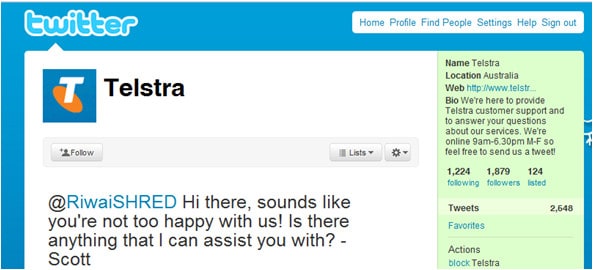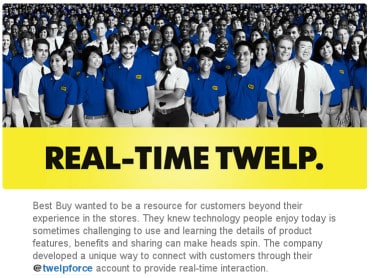It is clear that leading brands are using Twitter and other social media channels to deliver reactive service to their customers.
Probably the best known of these is BestBuy with their @twelpforce Twitter account. Staff at the computer chain use their Twitter accounts to answer questions from customers all over the country.
Less well known, outside Australia, is the use that Telstra are also making of Twitter to “reach out” to customers who voice concerns or issues with Telstra products via their personal Twitter accounts.

But are the hotels featured in this Wall Street Journal article (‘I Hate My Room,’ The Traveler Tweeted. Ka-Boom! An Upgrade!) taking things one step too far? In summary, the story discusses how hotel chains are listening on Twitter to pick up service issues that their customer are having. Then they are diving in to help resolve the customer’s problem. Nothing wrong here.
It’s the next step that I start to wonder about. It seems that the number of followers a person has on Twitter may be determining the sort of response that the hotel provides. If you have a lot of followers then you seem more likely to get room upgrades and free cocktails.
This leaves me questioning two things:
Why are you training your most visible customers to complain?
Don’t get me wrong having an open ear to customer complaints is a great way to hear what is going wrong in your organisation and fix it. However, if you start to train your customers that for every negative Tweet that they send they receive a positive reward then you’re going to breed an army of people complaining long and hard about every little thing, real and imagined.
And you know that the high volume “road warriors” are going to learn this faster than anyone. It won’t be long before you’re spending all of your time running around giving everybody on Twitter, a room upgrade. Which brings me to my second question:
Is this a zero sum game?
This seems to me like the start of a new zero sum game, similar to the one the airlines embarked on when they invented the Frequent Flyer program. If you give everyone who complains a room upgrade, then pretty soon everyone is complaining and you have to give everyone a room upgrade, and so do all of your competitors.
Then you’re back to where you started because someone still has to get the room by the air conditioner.
I don’t think that the solution to this issue is to ignore the new service channel. Using Twitter as a service input and customer resolution channel is a great idea and has worked really well for organisations that have embraced it.
Perhaps the issue is that organisations are focusing too much on surprise and delight in an effort to drive customer loyalty rather than the basics of just solving customer problems. This new Harvard Business Review article (Stop Trying To Delight Your Customers) has a good take on the issue. It shows new research that customer loyalty is driven more by solving customer problems quickly and accurately, rather than spending time trying to surprise and delight customers.
Of course, social media can be used in very productive ways to improve customer loyalty and generate real company value.
I've created an Excel Customer Lifetime Value Calculator: Download Here









